D-DAY CEMETERY ESTABLISHED IN FRANCE
Colleville-sur-Mer, Normandy • June 8, 1944
On this date in 1944, 2 days after the D-Day landings, a small piece of Normandy, France, became the site of the first American military cemetery to be established in Europe during World War War II. On that first day the makeshift graveyard near the badly damaged village of Colleville-sur-Mer was lined with several rows of crosses each draped with a soldier’s dog tag. Bodies of men from the U.S. 1st and 29th Infantry Divisions that had piled up on nearby Omaha Beach on June 6 now lay in neat rows ready for burial. The carnage on the shoreline was awful. A work detail of German POWs (among the first of 200,000 POWs) used 2‑wheeled farm carts to bring the bodies up the Colleville draw from the invasion area to their new resting place on top of the bluff—sections that were identified by letters of the alphabet so that the work details could lay the bodies out by the last name (family name) on their dog tag. There were no coffins for the dead, just bed sacks tied at the end.
After the war a permanent cemetery was established at Colleville not far from the original graveyard. Also after the war the U.S. government gave relatives the option of leaving their loved ones in war graves in Europe or reburying them in America. The families of 60 percent of the 30,000 American soldiers killed during Operation Overlord chose to have the bodies of their loved ones repatriated. Sitting on a bluff overlooking Omaha Beach and the English Channel, the 172‑acre/70‑hectare Normandy American Cemetery and Memorial is laid out in the form of a Latin cross and contains the graves of 9,387 U.S. servicemembers, average age 24, most of whom lost their lives in the D‑Day landings and ensuing operations. Each gravestone points west, towards home.
The memorial consists of a semicircular colonnade; in the center is a 22‑ft./6.7‑m bronze statue, “Spirit of American Youth Rising from the Waves.” On the Walls of the Missing, in a semicircular garden on the east side of the memorial, are inscribed 1,557 names of the men whose bodies were never recovered. In a chapel at the heart of the rows of dead are inscribed these words: “Think not only upon those passing. Remember the glory of their spirit.” Those interred in the Colleville cemetery are among the more than 93,000 World War II casualties buried overseas, representing roughly 23 percent of the 400,000 Americans who never returned home.
Normandy Cemeteries
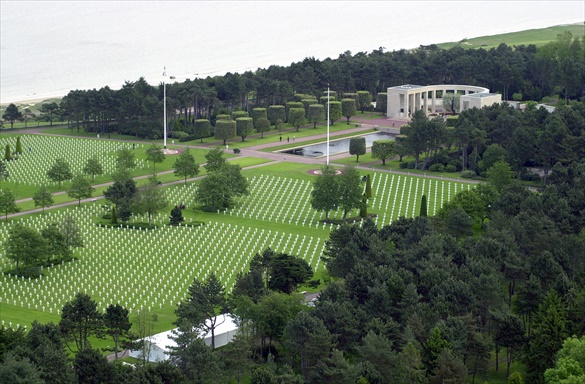 |
Above: On a bluff overlooking Omaha Beach and the English Channel and roughly 170 miles/274 km west of the French capital, Paris, is the Normandy American Cemetery and Memorial. Dedicated on July 18, 1956, the memorial consists of a semicircular colonnade with a portico at each end. The porticos contain large maps and narratives of the military operations that liberated this part of France. In the colonnade’s center is the 22‑ft./6.7‑m bronze statue “Spirit of American Youth Rising from the Waves.” It faces west toward the reflecting pool and headstones beyond the pool. On the other side of the burial area is a circular chapel. Inside, a ceiling mosaic depicts Columbia (representing America) and Marianne (representing France). Columbia is shown blessing her departing sons, while Marianne bestows a laurel wreath upon the American dead. At the far end are 2 granite statues, one representing the United States, the other France. An orientation table overlooking the beach depicts the Normandy landings, the largest amphibious invasion of all time and the first step in the Allied liberation of France and the rest of Northwest Europe. Opened in May 2007, a $30 million visitor center continues the story of the 9,387 Americans buried there and puts the D‑Day landings and follow-on battles in Europe in perspective. The Normandy American Cemetery and Memorial receives over 1 million visitors each year, after Arlington National Cemetery the most heavily visited American military cemetery. The Normandy cemetery has been granted use of the site in perpetuity by the French government to the United States, tax and rent free. All American cemeteries in foreign lands are under the jurisdiction of and maintained by the American Battle Monuments Commission, headquartered in Arlington, Virginia.
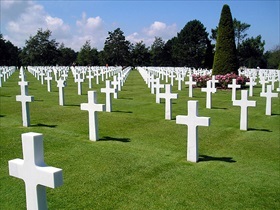 | 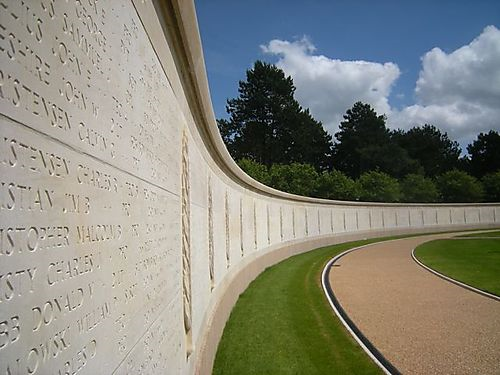 |
Left: A central mall bisects the cemetery’s ten burial plots. The fallen servicemen and women lie beneath precisely aligned headstones of white Lasa marble Latin crosses (9,238) and Stars of David (149). A French couple founded Les Fleurs de la Memoire (Flowers of Memory), an organization that encourages French families to put flowers on the graves of the soldiers buried at the American Cemetery and Memorial. As of August 2011, 8,500 graves had been adopted, the numbers growing by the year.
![]()
Right: On a series of wall-mounted tablets in the semicircular Garden of the Missing on the east side of the memorial are inscribed 1,557 names of those who went missing in action in this region of France. A bronze rosette next to a name indicates that the remains were later recovered, identified, and buried.
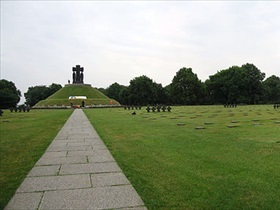 | 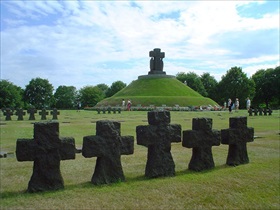 |
Above: La Cambe German War Cemetery is the largest of 6 German cemeteries in Normandy. Located close to Bayeux, France, it contains the remains of 12,000 German soldiers who were moved in from 1,400 locations in the French departments of Calvados (Lower Normandy) and the Orne. Since La Cambe’s inauguration in September 1961, the remains of over 700 more soldiers, scattered on battlefields across Normandy, have been reinterred at La Cambe. A large tumulus, or mound of earth and stones, marks the resting place for 207 unknown and 89 identified German soldiers interred together in a mass grave. Topped by a large dark cross in basalt lava, the tumulus is surrounded by 49 rectangular grave fields with up to 400 graves each.
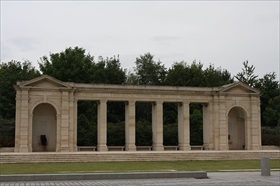 | 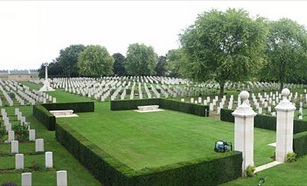 |
Left: Located in Bayeux, Normandy, the Bayeux War Cemetery is the largest World War II cemetery of British Commonwealth soldiers in France. The cemetery contains 4,648 burials, mostly of the Normandy invasion. In addition to the Commonwealth burials, there are 466 graves of German soldiers.
![]()
Right: The Bény-sur-Mer Canadian War Cemetery contains predominantly Canadian soldiers killed during the early stages of the 77‑day Battle of Normandy. The cemetery is located in and named after a commune in the Calvados department near Caen, the site of fierce fighting by British and Canadian troops. Canadian soldiers killed later in the Battle of Normandy are buried south of Caen in the Bretteville-sur-Laize Canadian War Cemetery located in Cintheaux, between Caen and Falaise in Lower Normandy.
American War Cemeteries Around the World. Set to “Hymn to the Fallen” by John Williams
![]()

 History buffs, there is good news! The Daily Chronicles of World War II is now available as an ebook for $4.99 on Amazon.com. Containing a year’s worth of dated entries from this website, the ebook brings the story of this tumultuous era to life in a compelling, authoritative, and succinct manner. Featuring inventive navigation aids, the ebook enables readers to instantly move forward or backward by month and date to different dated entries. Simple and elegant! Click
History buffs, there is good news! The Daily Chronicles of World War II is now available as an ebook for $4.99 on Amazon.com. Containing a year’s worth of dated entries from this website, the ebook brings the story of this tumultuous era to life in a compelling, authoritative, and succinct manner. Featuring inventive navigation aids, the ebook enables readers to instantly move forward or backward by month and date to different dated entries. Simple and elegant! Click 











